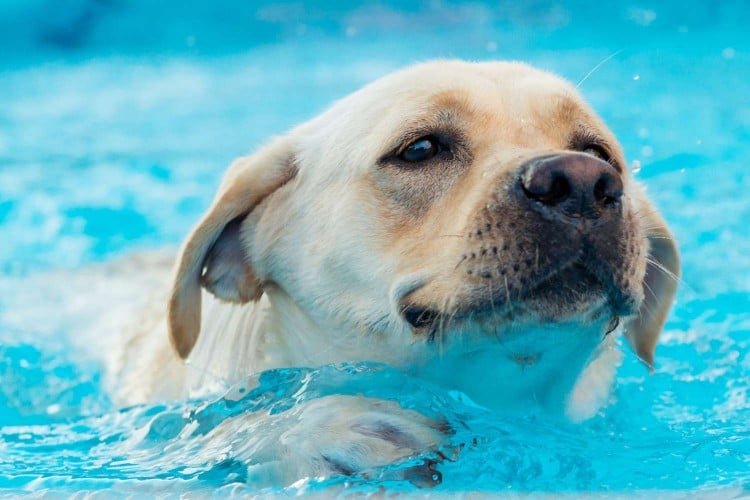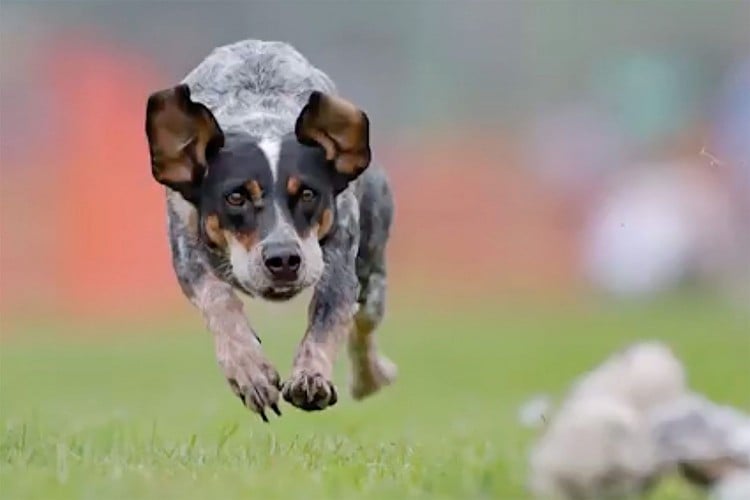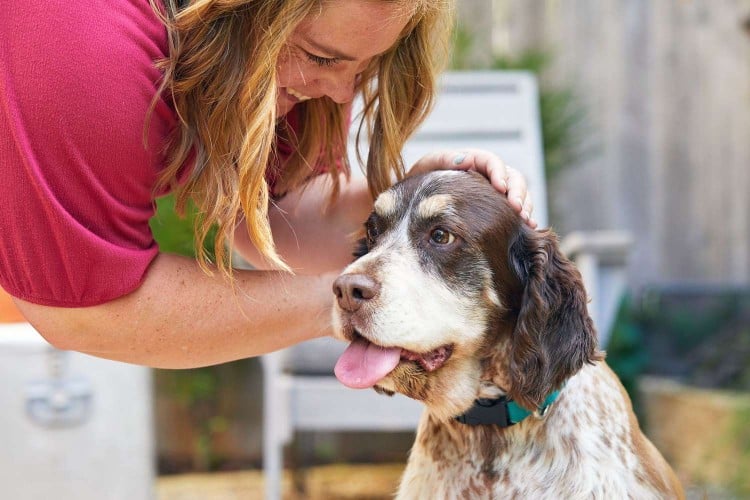
As summer approaches, it's time to ready the backyard pool, head to the beach, or put the boat in the water. You're sure ready to take a dip, but is your doggy ready to ... paddle?
Teaching your dog to swim can have some excellent benefits: It's good exercise; it can help a puppy's mental and physical development; and it's yet another way for you to spend time with your best buddy.
If you're wondering how to teach your dog, you've come to the right place. We've enlisted Kyle Smith, the canine swim instructor at Green Leaf Pet Resort in New Jersey, to give us the best tips and tricks on swimming with your dog. (After all, he taught the Trenton Thunder's bat-collecting golden retrievers, Rookie and Dash, how to swim.)
"It's all about making it as positive as we possibly can so they can start to enjoy the pool," he says.
When Should You Teach Your Dog to Swim?
You can really start at any point in your dog's life if you want to, Smith says, but he recommends beginning when your dog is between 6 months and 2 years old.
That's when dogs are developing physically and mentally. Plus, dog owners have told Smith the exposure to swimming gives their pups the confidence to try other things like jumping into and out of the car and going up and down the stairs with more surety.
But if you want to teach your older dog to swim, don't be afraid to try.
"They're kind of set in their ways, so it makes it a little more difficult, not to say that it can't happen, but it does make it a little more difficult," Smith says.
Here's the Best Way to Teach Your Dog to Surf or Stand-up Paddle Board With You
3 Easy Steps to Teach Your Dog to Swim
Here's what you'll need: your swimsuit, a life jacket for your dog, maybe a toy or two, some treats, a positive attitude, and plenty of patience.
As for the location, Smith says you can teach your dog to swim in a lake or ocean, but a swimming pool might be the best option. With beaches, it's easy for your dog to get in and out of the water, but you are in an otherwise uncontrolled environment. In a backyard pool, it might be harder for your pup to get into the water, but you're in control of everything.
Also, you're gonna have to go in the water with your dog. They need your help, and you standing on the sidelines will actually torpedo the process before it really even starts.
"That's going to put way more stress on them when they see you on the outside of the water and they're in the water—and especially if they don't know where to go," Smith says. "That's just going to drive them pretty much crazy."
Here's Smith's step-by-step guide to teaching your dog to swim.
Step 1: Introduce Your Dog to the Pool
Bring your dog to the pool, Smith says. This is where you'll almost hang out for a few minutes. You can play with a toy, give your dog some good pets and maybe a few treats. Then start walking around the pool, letting your dog get the lay of the land. If you haven't already, put your pup's life jacket on.
The 8 Best Dog Pools for Fun in the Sun
Step 2: Get Into the Water
Now is when you start to descend the stairs into your pool. If this is your dog's first try, he probably won't follow you, Smith says. So be patient, and help place your dog's front paws onto the first step in the water. Eventually, position their paws so they're standing in the water. Shower them with love and encouragement, lots of "good boy!" and "good girl!'
Step 3: Swim!
Smith says you should continue to ease your dog deeper into the water until their feet no longer touch the ground. Stay right by his side, guiding him around the pool with his life jacket. If you don't have a life jacket, place your hand under his belly, Smith says.
"It's only going to help them calm down," Smith says. "That's all we really want: for them to calm down so they can actually start to use their brain."
You'll also want to play a little defense here. About 90 percent of the time, a dog new to swimming will try to find the quickest way out, Smith says. Try to gently steer them away from the pool's walls where they might escape. If they're really gunning for the wall, let them approach it before gently saying "no" and guiding them away with plenty of encouragement and love as they start swimming again.
This is when you can introduce an element of fun, like a fetch toy, to show your dog that the pool is supposed to be a positive experience.
Now, if your dog is obviously in great distress while in the water, let them leave the pool and maybe try again later or on another day. If you're tried a few times and your dog obviously hates it, swimming isn't for him and you should focus on enjoying your time together on land.
"You can't force this," Smith says.
All Paws on Deck: How to Go Kayaking With Your Dog
What Not to Do While Teaching Your Dog to Swim
Speaking of forcing things, don't under any—any—circumstances just throw your dog into the water and expect them to swim. It's about the worst thing you can do, Smith says. Not only will your dog likely panic because they've never swam before and you're not in there with them, the experience might be traumatic enough to make them afraid of the water in the future.
The same is also true for dogs whose first experience with swimming is accidentally falling in, which is why it's important to keep your pool covered when not in use and always supervise your pup when they're nearby any body of water.
"You can really just see how scared and nervous they are just initially, as soon as we open the pool door," Smith says.
Does My Dog Need a Life Jacket to Swim?
Your dog can swim without one, but Smith recommends fitting one for your dog. He usually recommends dogs swimming in pools wear jackets, but he said any dog swimming in an uncontrolled environment like a lake or ocean—where they could get stuck in open water—should wear one.
Do Dogs Need Life Jackets? What To Know For Your Summer Adventures
For him, life jackets aren't a teaching tool, they're exclusively for safety.
"The life vest isn't there to show the dog how to swim," he says. "The life vest is there to help the dog if he's doing it completely wrong and keeps him from drowning."
How Long Does Teaching Your Dog to Swim Take?
That depends on the dog, Smith says. For him, it usually takes about three or four sessions on average for a dog to be comfortable swimming. However, some dogs figure it out the first time they touch the water while others might suddenly have something click during their fifth try.
Others, of course, might never become swimmers. And that's OK!
Can All Breeds of Dogs Swim?
For the most part, yes, Smith says. Some dogs might have a genetic disposition to swimming—think water dogs like poodles, Labrador retrievers, or Chesapeake Bay retrievers—but you can teach almost any breed to swim, he says.
But when it comes to flat-faced brachycephalic dogs like bulldogs and pugs, it might be best to stay on land. Because of their facial structure, it can be hard for these breeds to keep their noses above water, even with a life jacket, to breathe and that can put them at an increased risk of drowning.
If you have to try, have a professional like Smith who teach them to swim all while making sure they're safe.
"They're going to breathe more heavily and things like that, so you're going to want to monitor them," he says.





